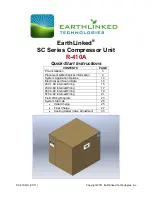
2
Chapter 1
I.
Introduction
In the interest of promoting safety in the refrigera-
tion and air conditioning industry, Tecumseh Prod-
ucts Company has prepared the following
information to assist service personnel in safely
installing and servicing equipment. This section
covers a number of topics related to safety. However,
it is not designed to be comprehensive or to replace
the training required for professional service person-
nel.
II.
Trained Personnel Only
Refrigeration and air conditioning devices are
extremely complicated by nature. Servicing, repair-
ing, and troubleshooting these products should be
done only by those with the necessary knowledge,
training, and equipment.
III.
Terminal Venting and
Electrocution
Improperly servicing, repairing, or
troubleshooting a compressor can lead
to electrocution or fire due to terminal
venting with ignition. Follow the pre-
cautions below to avoid serious injury
or death from electrocution or terminal
venting with ignition.
A.
Fire Hazard from Terminal
Venting with Ignition
Oil and refrigerant can spray out of the compressor
if one of the terminal pins is ejected from the her-
metic terminal. This “terminal venting” can occur as
a result of a ground fault (also known as a short cir-
cuit to ground) in the compressor. The oil and
refrigerant spray from terminal venting can be
ignited by electricity and produce flames that can
lead to serious burns or death. When spray from ter-
minal venting is ignited this is called “terminal vent-
ing with ignition.” See Figures 1-1 through 1-3 for
detail.
B.
Terminal Venting and Electrocution
Precautions
To reduce the risk of electrocution, serious burns, or
death from terminal venting with ignition:
➤
Disconnect ALL electrical power before
removing the protective terminal cover.
Make sure that all power legs are open.
(NOTE: The system may have more than one
power supply.)
➤
Never energize the system unless: 1) the pro-
tective terminal cover is securely fastened,
and 2) the compressor is properly connected
to ground.
Figures 1-4 through 1-6 illustrate the different
means of fastening protective terminal covers.
➤
Never reset a breaker or replace a fuse with-
out first checking for a ground fault (a short
circuit to ground).
An open fuse or tripped circuit breaker is a
strong indication of a ground fault. To check
for a ground fault, use the procedure outlined
in “Identifying Compressor Electrical
Problems” on page 47.
➤
Be alert for sounds of arcing (sizzling, sput-
tering or popping) inside the compressor. If
you hear these sounds, IMMEDIATELY get
away.
➤
Disconnect power before servicing.
Always disconnect power before servicing,
unless it is required for a specific
troubleshooting technique. In these situations,
use extreme caution to avoid electric shock.
WARNING
!
Never service, repair, or troubleshoot
unless you are a professional air condi-
tioning/refrigeration service person.
Improper servicing can lead to serious
injury or death from fire, electric shock,
or explosion.




































